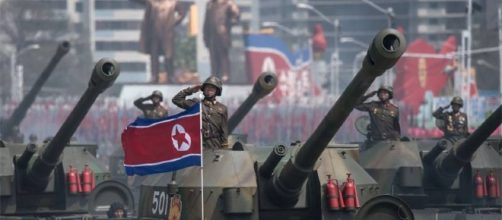The American submarine USS Michigan was docked in South Korea Tuesday. On the same day, Pyongyang held a large live-fire exercise to mark the 85th anniversary of the communist country’s military.
Defying UN sanctions
There are fears that North Korea would make another nuclear test or long-range missile launch to defy UN sanctions, New York Post reported. Pyongyang apparently deployed a big number of long-range artillery units in Wonsan region on the peninsula’s east coast.
North Korean leader Kim Jong-un possibly supervised the military exercise, according to an unidentified South Korean government source.
Despite the UN sanction, North Korea insisted its military is prepared to end the scheming and nuclear blackmail of the U.S.
Rodong Sinmun, the official newspaper in North Korea, said in a front-page editorial, “There is no limit to the strike power of the People's Army armed with our style of cutting-edge military equipment, including various precision and miniaturized nuclear weapons and submarine-launched ballistic missiles,” Reuters reported.
The USS Michigan carries ballistic and cruise missiles. The Navy of South Korea said it would hold its live-fire exercise with American destroyers in waters west of the Korean peninsula. It would join the USS Carl Vinson aircraft carrier strike group deployed by U.S.
President Donald Trump for military exercises off the Korean peninsula to warn Pyongyang.
Japan urges citizens
Despite North Korea’s boast that it could deploy missiles that could reach the U.S., the intercontinental ballistic missile it deployed proved to be a dud because it exploded five seconds after it was fired. Pyongyang fired the ICBM one day after the country held a parade to mark the 105th birthday of Kim Il-Sung, the founding father of the communist nation.
Among the reasons why the North Korean missile fizzled is the system is not sufficiently competent to make it work, Sir Malcolm Rifkind, ex-Conservative foreign secretary, said. He added the U.S. possibly used a cyber method to interrupt Pyongyang’s ICBM.
However, The Washington Post reported that North Korea’s missiles may not yet be capable of reaching the U.S., contrary to Pyongyang’s boast, but it could reach Japan, a U.S. ally. In case North Korea fires a missile directed at Japan, Tokyo would possibly have less than 10 minutes to warn its citizens.
In anticipation of such an attack, the office of Japanese Prime Minister Shinzo Abe issued new guidelines on how Japanese citizens could protect themselves in the case of a North Korean missile attack. For Japan residents who would get the warning on time, the advice of the government is to seek shelter in a stronger building.
On Feb. 7, 2016, Pyongyang launched a ballistic missile which took only 10 minutes to fly over Okinawa.
When North Korea launch four missiles on March 6, three fell in the exclusive economic zone of Japan in the Sea of Japan. Pyongyang said it was a practice to hit the U.S. military bases in Okinawa, Japan.

